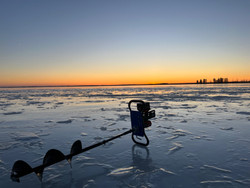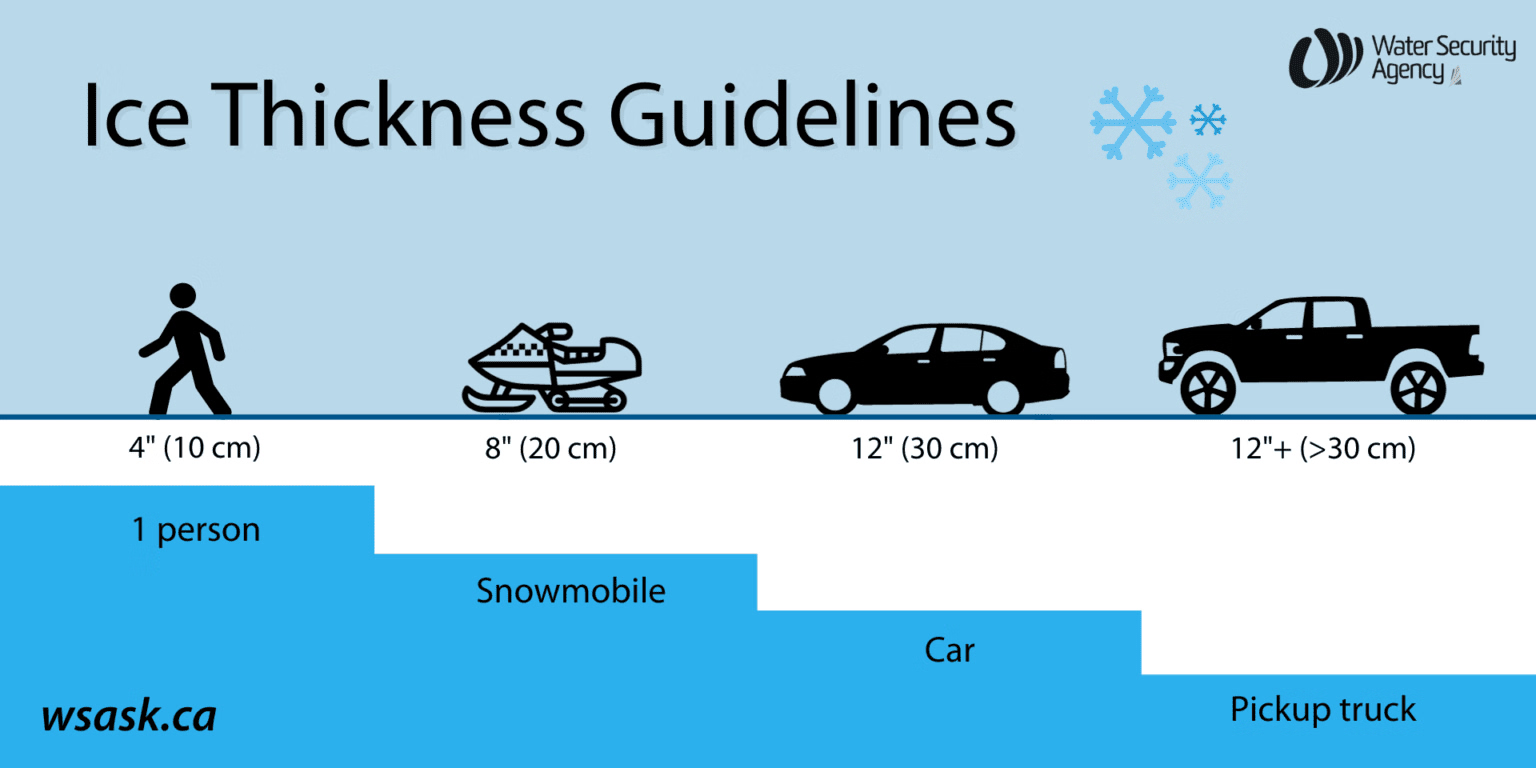Ice Fishing

Ice fishing is an increasingly popular activity on thousands of lakes across Saskatchewan every winter. It's a great way to keep enjoying our beautiful lakes and scenery during our long, cold Saskatchewan winters. There is a large and very vibrant ice-fishing community in the province with large clusters of ice-fishing shacks and tents forming on many lakes every winter.
One advantage of ice fishing is that you can get out on the lake without a boat, by snowmobile, truck on on foot. Some lakes and locations are much easier to access during the winter than in the summer. There are even some more remote spots that are only accessible by snowmobile during the winter and are virtually inaccessible during the boggy summer season.
The majority of the information on this page is relevant when fishing on provincially managed waters in the province. The season and rules are managed differently within Prince Albert National Park.
Table of Contents
- Season
- Additional Restrictions
- Ice Safety
- Where to go
- Outfitters and Lodges
- Competitive Fishing Events (Tournaments and Derbies)
- Ice Shacks
- Rent an ice fishing shack
- Ice Fishing in Prince Albert National Park
- FAQ
- References
Season
The ice fishing season in Saskatchewan starts as soon as the ice is safe (often in the middle of December). The season closes on March 31, 2025 in both the Southern Zone and Central Zone. The season closes on April 15th, 2025 in the Northern Zone. In some years ice fishing may no longer be possible/safe earlier than that depending on the quality of the ice around the province.
Additional Restrictions
In addition to the regular fishing restrictions, there are a few additional rules around ice fishing particularly when fishing on provincially managed waters. I've referenced the full list from the provincial website below.
- Two lines may be used when ice fishing, but they must be within sight and 25 metres (27.3 yards) of the person who set or is using them.
- Only gaffs with a J-hook end may be used to land fish while ice fishing, but they cannot be more than 1.5 metres (1.6 yards) long. Use or possession of a spear on ice-covered waters is prohibited.
- Ice fishing shelters south of Highway 16 must be removed from the ice no later than March 15. Ice fishing shelters north of Highway 16 must be removed no later than March 31.
- Storing or leaving ice fishing shelters on public land, or on private land without the landowner's consent, is prohibited.
- Ice fishing shelters left unattended on the ice must have the owner's full name, address and phone number in legible letters at least 2.5 centimetres (1 inch) high on the outside of the shack.
- Use of ice fishing shelters for the purpose of outfitting, without a licence, is prohibited. For more information, please refer to Ice shack rentals and outfitting – what you need to know. ice fishing - saskatchewan.ca
Ice Safety
If you are going to be ice fishing, it stands to reason you'll need to be out on the ice. This brings certain dangers with it, and safety should be top of your mind when transporting out your gear and fishing on the ice.
Things to remember:
- Ice freezes differently depending on many different conditions. Just because the ice is good in one spot, doesn't mean it will be the same everywhere on the lake.
- Don't rely on reports from others about ice thickness, or your previous experience, always check ice thickness for yourself.
- Ice thickness is not the only factor that affects ice safety. Clear, hard ice is recommended for travel.
Things that reduce ice safety:
- Moving water will reduce the ability for ice to form, and weaken existing ice. Many of our lakes have moving water near outlets/inlets. We also have many reservoirs that are formed on rivers with currents that can affect ice. Even springs in lakes can cause weaker ice. There are a few spots directly in front of my cabin where the ice is never quite as thick and water is coming up through the sand.
- Ice that has frozen, melted, then frozen again.
- Ice that looks slushy.
- Ice that is layered.
- Ice that has pressure ridges or other structures in it.
Ice safety on rivers
As already mentioned, moving water is a major hazard on the ice. So it makes sense that ice on rivers, streams, etc. is generally less consistent and more hazardous to be on. Remember that we have many lakes that are just wide areas on a river in the province. These were created and are controlled by dams. The water flow and ice conditions can change depending on how the dams are being managed. Always be especially careful if you're venturing out on any rivers or anywhere with moving water.
Ice Thickness Guidelines
The following thickness guidelines are provided by the WSA:
- 10 cm / 4 inches for walking
- 20 cm / 8 inches for a snowmobile
- 30 cm / 12 inches for a car / light truck
- More than 30 cm / 12 inches for a heavy truck

Remember, if you're not sure the ice is safe... stay off!
Where to go
Just about anywhere in the province, you'll be able to find an opportunity for ice fishing within a few hours.
There are some incredibly popular ice-fishing lakes in the Southern portion of the province including: Lake Diefenbaker, Last Mountain Lake, Pasqua Lake, and Crooked Lake.
Near Saskatoon Blackstrap Lake is a popular winter destination for Perch.
Heading further North Tobin Lake holds the world record for the largest Walleye caught ice fishing and is well worth a visit. Turtle Lake is another large lake that produces some nice fish.
Outfitters and Lodges with Ice Fishing Packages
Although most fishing lodges and outfitters in the province only operate during the summer, there are a few that will be happy to host you on an ice-fishing adventure. Unlike the fly-in opportunities that exist in the summer, all of these are accessible on the road system.
A few of these include:
- Thompson's Resort at Otter Lake
- Tobin Lake Guide Services at Tobin Lake
- Twin Marine Outfitting at Tobin Lake
- Twin Bay Resort at Deschambault Lake
- Fishing Geeks at Lake Diefenbaker
- Marshland Fishing at Lake Diefenbaker
- Saskatchewan Outdoors Guide Service at Last Mountain Lake and Fishing Lakes
- Prairie Pro Outfitters at Rafferty Reservoir
- T&D Amisk Camp at Amisk Lake
Ice Fishing Shacks
Please note the following regulations for ice fishing shacks from the Sask Anglers Guide: Ice fishing shelters south of Highway 16 must be removed from the ice no later than March 15. Ice fishing shelters north of Highway 16 must be removed no later than March 31. Storing or leaving ice fishing shelters on public land, or on private land without the landowner's consent, is prohibited. Ice fishing shelters left unattended on the ice must have the owner's full name, address and phone number in legible letters at least 2.5 centimetres (one inch) high on the outside of the shack. If you are ice fishing on Waskesiu Lake, an ice shack is permitted but it must be removed every night.
Rent an ice fishing shack
If you're interested in renting a shack to make your fishing trip a bit cozier there are a few outfitters that have shacks for rent in the province:
- Crooked Lake Outfitters
- Anglers Trail Resort at Lac La Plonge
- Thompson's Resort at Otter Lake
- Dore Lake Lodge
- Tobin Lake Resort
- Prairie Pro Outfitters at Rafferty Reservoir even offers overnight stays
Please be aware that if you are renting out your ice fishing shack, you may need an outfitters license.
Competitive Fishing Events (Tournaments and Derbies)
Every winter there are many different fishing tournaments and derbies across the province. They are a great way to get out on the lake and often help to support local causes. The Montreal Lake Walleye Derby is the most well-known, with the biggest prize payout but there is an increasing number of events happening every winter in the province. Visit the SaskLakes Calendar to see upcoming fishing events.
Ice Fishing in Prince Albert National Park
If you're hoping to do some ice fishing within Prince Albert National Park, you're in luck! You will have to follow a few rules though. The only lake in the park that is open for ice fishing is Waskesiu Lake. No vehicles are allowed on the ice, so you'll need to walk your equipment out onto the lake. You'll also require a valid Prince Albert National Park fishing permit. Learn more about fishing in the National Park
FAQ
When can I start ice fishing in Saskatchewan?
As soon as the ice is safe to travel and fish on you can start ice-fishing. This is generally around the middle of December.
When does ice fishing season end in Saskatchewan?
The ice fishing season ends when the ice gets soft or when the season is closed by the government whichever comes first. The fishing season closes on March 31, 2025, in the Southern and Central Zones and on April 15, 2025 in the Northern Zone. Many lakes with stocked trout are open for fishing all year long. On these lakes the season only ends when the ice is no longer safe.
What kinds of fish can I catch ice fishing in Saskatchewan?
There are lots of different species that can be caught through the ice in Saskatchewan. Some of the most popular include Northern Pike, Walleye, Yellow Perch and Rainbow Trout.
References
- https://www.saskatchewan.ca/residents/parks-culture-heritage-and-sport/hunting-trapping-and-angling/angling/regulations#ice-fishing
- https://parks.canada.ca/pn-np/sk/princealbert/activ/experiences/activites_hivernales-winter_activities
- https://pubsaskdev.blob.core.windows.net/pubsask-prod/109459/Winter%252BIce%252BSafety%252BFact%252BSheet.pdf
- https://www.tourismsaskatchewan.com/blog/2023/02/15/guide-to-ice-fishing-in-saskatchewan
- https://www.iceshanty.com/ice_fishing/index.php?board=28.0
- https://www.saskatchewan.ca/government/news-and-media/2024/march/05/dont-leave-your-fishing-shelter-on-ice--remove-it-soon